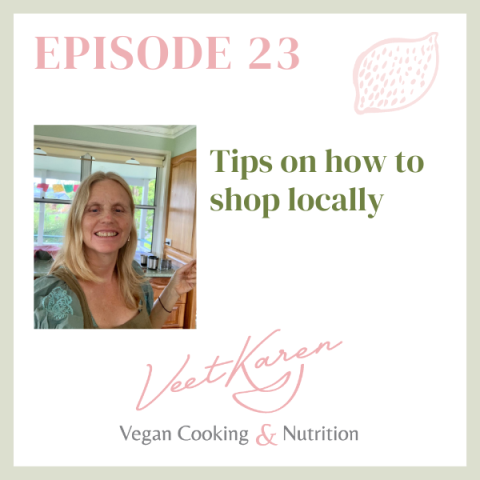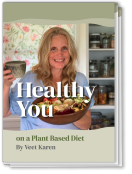
Episode 23
Tips on how to shop locally
Sourcing produce locally can start from, growing produce yourself, to going to local farmers markets, or speaking with your local independent grocers. In this podcast episode, I talk about what shopping locally means and how to buy more local produce and products.
Listen Now
Show Notes and Links
Interview with Helena Norberg-Hodge www.veets.com.au/16
For more information on the vegan chef training https://www.veets.com.au/vegan-chef-training
For more information on the vegan foundation cooking course https://www.veets.com.au/vegan-foundation-cooking-course
https://www.veets.com.au/blog/amaranth-and-carob-bars for the carob slice I mentioned, it is delectable and quite healthy.
Introduction
In episode 16, I spoke to Helena Norberg-Hodge on the impact of shopping locally. In this episode, I am going to break down what that actually means and how to make shopping locally easier for you.
Have you listened to podcast 16 yet?
I loved interviewing Helena Norberg-Hodge on shopping local and its impact on communities worldwide. If you haven’t listened yet, it is well worth a listen.
What buying locally means to me
In 2011 when I met Helena, I really committed to shopping local and it was relatively easy as we have great farmers markets with a lot of produce and products are produced in Australia.
So in all of my business since then, I have thought about where the ingredients I need are sourced from. In the catering I did and all the courses, including the vegan chef training, and even now when teaching online, I buy as locally as I can.
I also mention this all through the classes and trainings. This has filtered through to the vegan chef training graduates. When you listen to Ems and Tenzin’s interview, they talk about buying locally and Jesika sources only Australian beans to make her tempeh. If you head on over to Ebony’s Insta, you will see she sources local produce too.
I really have stayed true to my beliefs, that buying local will really benefit us all in the world and can potentially end poverty by allowing people to have what they farm in their countries to eat for themselves and not be exported to another country.
Why buy locally?
There are crazy true stories going on a daily basis, where tonnes of potatoes are being flown into China from the US and then potatoes flown from China to the US. It makes no real sense at all.
Or in the UK, you can’t find an apple grown in the UK as they have been transported to Europe, so you eat Spanish apples in the UK. I hope that has changed now, but that is how it was when I last visited.
So yes local local local.
However there are some things that are not possible to get locally.
For example, certain spices that I was and have always been using, that aren’t grown in Australia.
Lets use cumin as an example.
It is not grown in Australia, so the one I am buying is coming from India.
Does this mean I would have to give up using cumin – no.
Spices have been traded for 4000 years, so no, we don’t have not to use spices coming from overseas in order to be committed to buying locally.
So if we are buying 80, 90, 95% local, then the cumin coming from India is having less of an impact.
Tips on buying locally
The order I do things in to be buying mainly local produce is:
1. What can I source from my own garden.
I grow ginger, turmeric, garlic in small amounts, pumpkins, citrus, some herbs and most months lettuce.
2. There are also food share boxes in our area, where people put produce out that is excess, you don’t always know if this is organic but you can definitely know that it is local.
3. What can I source locally.
I go to the farmers market and also to the health food store, where they get fresh produce from local farmers and the organic market in Brisbane.
4. Then I do look at using products like carob more than raw cacao, as it has travelled less distance because carob is grown in Australia, but if I need to buy raw cacao, to show clients how to make raw cakes in the chef training, then I will buy that. But on a daily basis, I don’t use it because there are other more local ingredients I can use
One thing I do buy for daily use which is not at all local is seaweed, for some strange reason Australia isn’t yet producing seaweed.
So, I ensure I buy it from my local health food store, as we talk about ethical purchasing with the owners and in Mullum, Santos health food store, they have an ethics officer.
When you can talk to the owners of the stores you are purchasing your produce from ,you can really talk about where they are sourcing it from and if it is ethical.
Note: not everyone lives near a health food store, but even with independent grocers, you can discuss these things.
Buying organic also helps, as that is one step into being ethical. This is debatable, though, as there are big companies that are organic who don’t always think about the ethics.
Quinoa is a good example of that.
However it is a good place to start, by buying organic produce, especially if it is coming from further afield.
So I would:
Look at buying everything you can that is sourced in Australia.
Then the other things, buy organic, check with your shop if they know who the grower and supplier of the products you are buying from overseas, to see if it is coming from a small company or a large corporation.
Trying out local herbs or other ingredients in place of usual ingredients
Going back to using cumin. I use a lot of cumin, but having said that, I am also experimenting with different herbs, so that I can make use of what is in the garden, or grown locally.
I use lemon myrtle (which is the recipe I will share very soon).
I could use more bay leaves in Mexican food than cumin, as that works too, and bay leaves grow super well in my garden. As do curry leaves.
And lemon grass and makrut leaves (used to be called Kaffir lime) also grow super well, so I could gravitate more to south east Asian flavours, that can work without cumin.
There are so many ways to buy more local produce.
Shopping seasonally
Shopping seasonally also really helps, especially if you are in a country that imports a lot of fresh produce from other countries.
From November to April, in our area, avocados really don’t grow all that well, so during that time we don’t eat them.
In the very hottest months, sadly, lettuces don’t grow so well, so I make salad with grated cucumber and zucchini, as these do grow well then.
If you think about it, it goes back to what our great, great, great grandparents were doing. Creating food with what produce was on hand at that time of the year.
Recipe
(If you don’t live in Australia, you can use any other herb or nut in this, as a substitute lemon myrtle leaves and macadamia nuts).
Lemon myrtle dressing
8 lemon myrtle leaves
1/4 cup macadamia nuts
Splash of olive or flax oil
Juice of ½ to 1 lemon
Salt and pepper to taste
Blend until smooth.
Fun Cooking Tip
If you feel like a salad, but you don’t have any lettuce, raid your crisper and grate whatever veggies you can. Zucchini, cucumber and carrot, then cut up cabbage finely and celery, add herbs and voila, you have a fabby salad.
Have a sensationally delicious week, wonderful listener.
With gratitude Veet




